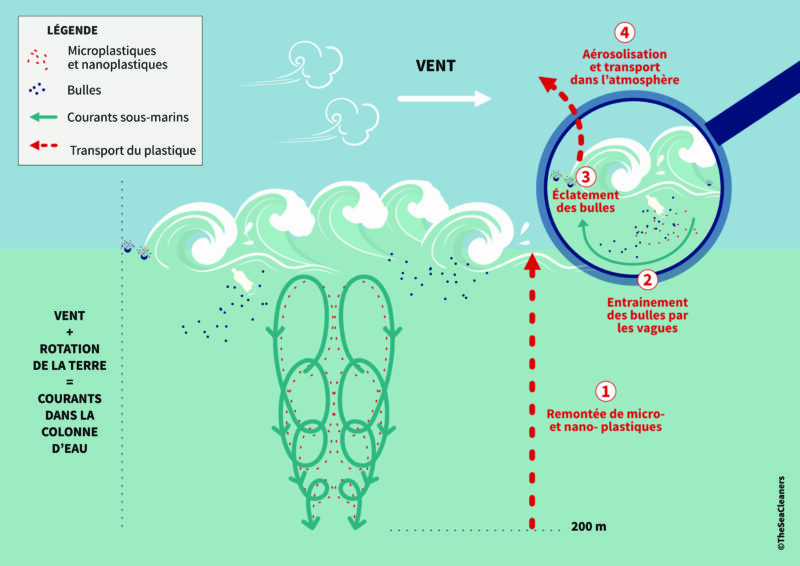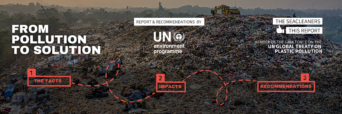Plastic, from the Ocean to the atmosphere
Plastic pollution
Science
17 March 2023
The Ocean is not only a dumping ground for plastic waste. It has also become a major emitter of plastic particles into the atmosphere. This is shown by scientific studies on the little-known phenomenon of plastic aerosolization, which contributes to air pollution.

Once released into nature, waste travels with the wind, rain, rivers and streams, and most often ends up in the oceans and seas, in various states of degradation.
Some are carried by the rivers flow and ocean currents, others are buried in the ground where they gradually mix with groundwater. Waste can also be carried by the wind. All of these wastes are part of what is called the “water cycle”. Water undergoes changes of state (solid, liquid or gas) as it circulates between the land, sea and atmosphere, and thus feeds various large reservoirs such as clouds, glaciers and oceans.
The ocean contains about 96.5% of the water on our planet, all states combined. It is estimated that between 9 and 14 million tons of plastic waste are dumped in the ocean each year (UNEP Report 2021). By accumulating this waste, it has become a major source of plastic emissions.
We know that large ocean currents and tides transport waste to beaches, but we know less about the effect of interactions between wind, currents and waves that bring tiny particles called microplastics from sometimes 200 meters deep, to the surface of the water and then into the atmosphere.
The currents therefore stir up waste and break it down into microplastics, until it becomes even smaller. These are the nanoplastics.
The water column, a waste elevator
A certain amount of plastic waste floats on the surface, but most of it is suspended in the water column (the area between the surface and the bottom of the ocean) in the form of microplastics and nanoplastics. They then move with the currents. Some particles sink to the bottom of the ocean while others are ingested by marine organisms and transported through the food chain. Finally, there is another phenomenon that we know even less about: the rise of plastic to the surface and its release into the atmosphere.
In concrete terms, how does this happen?
The rotation of the Earth coupled with the force of the wind gives rise to two types of currents (Ekman and Langmuir) which together are capable of bringing up microplastics and nanoplastics suspended in the water column. At the surface, wave action creates bubbles in or on which these plastic particles are trapped. When these bubbles come into contact with the air, they burst and vaporize water, sea salt, bacteria, viruses, microalgae and pollutants such as plastic particles into the atmosphere. This is the aerosolization of plastic from the oceans! (Allen et al. 2020). In other words, it is the process by which plastic turns into particles small and light enough to be carried by a gas.
This phenomenon of plastic aerosolization, although not well known, is an important source of air pollution...

A significant negative impact on the environment and health
Once in the atmosphere, plastic particles are transported by the wind to very large distances, in the same way as dust, sand or sea salt. Research in this area is still in its infancy, but it is already known that there is a presence and transport of microplastics in the troposphere, as evidenced by a study conducted on the Pic du Midi at an altitude of 2,877 meters (Allen et al.2021). It is also estimated that 31% of atmospheric microplastics are primary microplastics, i.e. plastic particles directly emitted into the atmosphere.
This aerosolization of plastic from the oceans is a worrisome phenomenon, as it has consequences for air quality and human health. Plastic particles contain toxic additives that, when released into the air, can cause respiratory problems, inflammation and lung disease. These particles are also deposited on soils, plants and freshwater, affecting ecosystems and biodiversity.
Plastic is now present everywhere in the water cycle, in all its forms, in the water table, in the ocean depths, in the clouds and on the mountain tops. It is therefore crucial to better understand the distribution mechanisms of microplastics and nanoplastics through the ocean water column, as well as their impacts on air quality and human health.
It is equally imperative to collect this plastic debris as close as possible to the dumping areas, when it is still floating macro-waste and concentrated, before it breaks down, decomposes, sinks and drifts. Before they become irretrievable.
Bibliography :
Liu et al. 2020. Elucidating the vertical transport of microplastics in the water column : A review of sampling methodologies and distributions
Allen, S. 2019. Atmospheric-transport-and-deposition-of-microplastics-in-a-remote-mountain-catchment
Allen et al. 2020.Examination of the ocean as a source for atmospheric microplastics
Allen,S et al. 2021. Evidence of free tropospheric and long range transport of microplastic at Pic du Midi Observatory
G. C. Cornwell, et al., Ejection of dust from the ocean as a potential source of marine ice nucleating particles. J. Geophys. Res. Atmos. 125, e2020JD033073 (2020).
https://www.nature.com/articles/s43017-022-00292-x https://www.theguardian.com/us-news/2019/dec/31/ocean-plastic-we-cant-see
https://www.science.org/content/article/ninety-nine-percent-oceans-plastic-missing
https://www.science.org/doi/10.1126/science.abc4428
